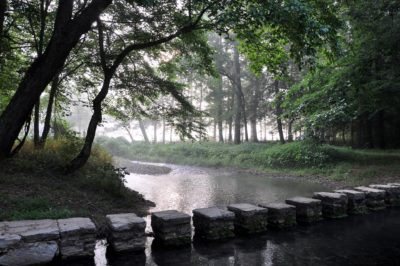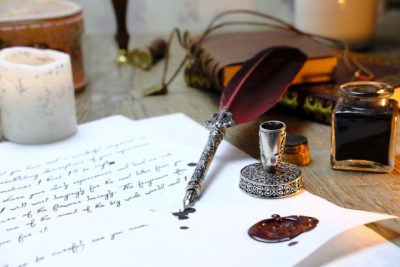Do you need ideas for stories? Venture out of your comfort zone. Traveling on the back roads, I’ve found a wealth of stories begging to be told.
My life changed in August, 1999, on my way home from a family reunion in Arkansas. Interstate 20 was under construction. Everywhere. After I crossed the Mississippi River at Vicksburg, I was delayed by yet another construction zone. Inching forward in the midday heat, I spotted a brown sign announcing an exit to the Natchez Trace.

I’d seen these signs before but had only a vague idea what the Natchez Trace was. I left the Interstate and entered a wealth of stories.
Originally a series of Indian trails, the Trace was a path for “Kaintucks” to return home from floating their goods down the Mississippi to markets in the south. Eventually it became a road used by travelers and armies between Natchez, Mississippi, and Nashville, Tennessee. The road fell into disuse with the rise of steamboat transportation and the construction of other roads. Then in the 1930’s, congressman Thomas Jefferson Busby proposed building the Natchez Trace Parkway as a work project for his unemployed constituents.
More than a road, the Trace is a 450-mile journey through history. Every few miles you’ll find a historical site with information on the people who lived and traveled here. At Mt. Locust, the Ferguson family operated an inn which still stands. Civil War sites include nearby Port Gibson, a town Ulysses S. Grant found “too beautiful to burn.” You’ll find ancient Indian mounds and sites pertaining to the Chickasaw and Choctaw nations before the white men banished them to Oklahoma. Grinder’s Stand, where Meriwether Lewis died in 1809, has been reconstructed. His cause of death is still a mystery. Was it suicide or murder?
My favorite is the Gordon House. John Gordon was the first postmaster of Nashville. Later, he operated a trading post and ferry on the Duck River in Tennessee. Signage says he built the two-story, brick house near the ferry site, but this isn’t quite true. He was away fighting Indians at the time, and his wife Dolly actually oversaw construction. The house was completed in 1818. John returned home from war in 1819 and died of pneumonia shortly afterward.
Dolly Gordon caught my imagination. She lived in the house until her death at age eighty, reared six children, operated the ferry, and oversaw the farm. She became a prominent figure in the area, brushing elbows with the likes of Davy Crockett and Andrew Jackson. Her son-in-law wrote, “She bore the burdens of their home, and was as brave and heroic as he [John].” I’ve researched Dolly’s life and plan to write a historical novel about her.
I no longer travel interstates. There’s too much of interest on the back roads. Another story I stumbled across is the Battle of Marks’ Mill, one of three Civil War battles fought in Arkansas. John Marks operated a saw and flour mill. On April 25, 1864, two armies clashed on the road in front of the family’s house. John and his wife Mary were away, but their daughters were home and watched the battle from their front porch.

Later, Martha Marks Hudson wrote, “I saw them shoot down the driver of the first wagon in front of my house. Our home was a temporary hospital, and I can see now, the wounded and the dying lying on our porches and in the house. General Sherman was right about war…it is hell.” Wow—what a story!
Just off the Blue Ridge Parkway in Fancy Gap, Virginia, sits the Sidna Allen house, a beautiful Queen Anne style home with a story that rivals any from the Wild West. Sidna built the house in 1911. He and his family lived there only one year before he was involved in the “Hillsville Massacre,” a shootout in the Carroll County Courthouse. His brother Floyd was on trial for “illegal rescue of prisoners.” Two of his nephews had been arrested and Floyd had forcefully released them from custody. When the guilty verdict was handed down, gunfire broke out in the courtroom between the Allen family and law enforcement. Five people died. Sidna and other relatives went to prison and Floyd died in the electric chair.
This story has been told many times. It made international news in 1912. Sidna wrote a book telling his side of the story. Carroll County puts on a play about the incident every year and when I stopped by the house two years ago, a documentary was being filmed. Still, few people outside Carroll County are familiar with this captivating tale, which begs for a wider audience.
Another story that crossed my path is more personal.

When my daughter lived in Virginia Beach, I passed through Kinston, North Carolina several times on my way to visit her. Kinston had seen two Civil War battles. The Historical Society has created a driving tour of the 1865 Battle of Wyse Fork. While doing genealogical research, I discovered that my ancestor, William Lewis Rogers, had fought in that battle. What a thrill to follow the path he marched, stand where his unit was entrenched, and imagine what that twenty-year-old youth must have felt! I later traced William’s journey through life, homesteading in Kansas, returning east, and settling in West Virginia, where his family married into a large extended family, also my ancestors, who’ve lived in the area since the 1700’s. One day I will write William’s saga and perhaps others from my family heritage.
In the meantime, I’ve used stories from my back road traveling in my blog. So, if you need material for writing, get off the Interstate, wander the back roads, and stop at points of interest. You’re bound to find something fascinating to write about.

Wendy Thornton
This is a wonderful blog! Thank you so much for the fascinating stories.
Marie Q Rogers
Thanks, Wendy
Bebe Black
I have enjoyed your other stories, Pat, and this shows the new facet of your life, which is most interesting. Keep them coming to my email if you like.
Marie Q Rogers
Thanks, Bebe
Joan H. Carter
You have found a goldmine of roads, Pat. You inspire me to explore more extensively the back country where my ancestors homesteaded. I’ll have to rent an RV to do it—no motels out there!
Marie Q Rogers
Thank you, Joan, and Happy Trails!